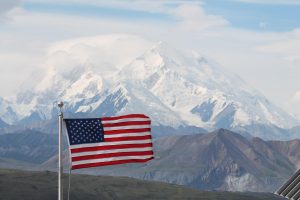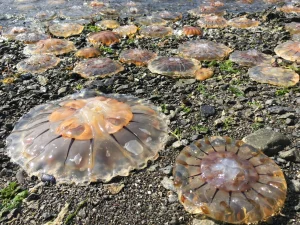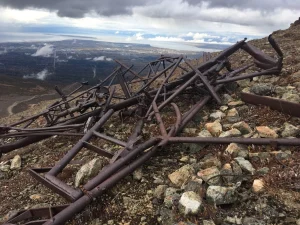Racing the Volcano
A pleasant flight through Lake Clark Pass becomes a fight for survival
(Published in Alaska Magazine, June, 2010)
Our Piper Super Cub finally reached the northern end of Lake Clark, still frozen and white, but bleeding dark patches of rotten ice on a sunny, late April day. We flew over a bare-but-budding Alaskan landscape. Swollen rivers gushed yellow with snowmelt. They reached laterally where they overflowed their banks and carved flood channels through willow thickets laden with furry buds. White flakes fluttered among the brush, dozens of ptarmigan feeding on spring growth.
Rob sat in front of me in the narrow fuselage, hunched over the stick of 33 Foxtrot. Even slouched, his shoulders appeared broad and confident, shoulders that cranked off 100 push-ups at parties while a skeptical onlooker held Rob’s beer. I rode in back, the only other seat in the two- place bush plane. Only, I didn’t have a conventional seat. Instead, I sat on coils of lead line and cork line, which we were hauling home to Anchorage to hang with new gillnet webbing to prepare for the June commercial salmon opening in Bristol Bay. My seatbelt extended over the mound and across my lap and lashed me to the plane along with the rest of our cargo.
It was 1990, and Rob and I were returning to Anchorage after a pre-season flight to Egegik to replace the exhaust manifolds on his 32-foot aluminum gillnetter. The trip, while work-related, felt equal parts adventure, work and vacation. Bristol Bay provided a welcome escape from the streetscapes and chaos of Anchorage. In July, at the peak of the salmon season, Bristol Bay is tense and chaotic. It supports the world’s largest sockeye salmon runs in its five major river systems. Roughly 3,000 commercial boats compete during a tight, six-week window as the salmon return to Bristol Bay, and eventually their birthplaces, to spawn.
But Bristol Bay is quiet in April. Beginning in September, the villages shrink to their normal size of a few hundred, or in some cases, a few dozen permanent residents, and they remain sleepy hamlets until the following June. Between flurries of work, we’d taken hikes across the windswept tundra and skimmed the shores between Egegik and Ugashik farther south, beachcombing for walrus tusks, crab buoys and Japanese glass fishing floats that travel the Pacific Ocean and wash ashore in winter storms. We circled gray whales just a stone’s throw off the beach as they scratched their bellies on the muddy bottom and rolled onto their backs to loosen barnacles. Square headed seals bobbed on the glassy surface, nostrils pinching and flaring, shiny pates reflecting evening sun, large, dark eyes inquiring. A bushy-tailed red fox in black knee socks tip-toed along, hunting voles among the sedge, beach pea and driftwood at the top of the beach.
Before long, we headed into Lake Clark Pass, a yawning mouth of braided rivers and gravel bars that narrows into dramatic rock faces adorned with hanging glaciers. Lake Clark Pass provides a safe and easy shortcut from Anchorage to Iliamna, Bristol Bay and the Alaska Peninsula to the southwest. Despite the pass being 40 miles long, it shaves miles and an hour’s time off the route around the lower Cook Inlet Coast and through stormy Shelikoff Strait. The only other option would be flying over the jagged Chigmit Mountains, on the south side of the pass, or the Neacola Mountains on the north side, a fuel-sucking, climb that offers no emergency landing sites.
As we entered the pass, Rob pointed out his side window to the southeast. While flying, we often alerted each other to a trophy bull moose or a grizzly sow with cubs, sometimes swooping down or circling back for a closer look. Other, more common wildlife such as eagles and caribou passed beneath us, silently noted. Rob’s alert was different this time. He didn’t point at the ground or along a rocky cliff ledge, but instead, across the mountain peaks to the distant horizon.
Confused, I first scanned the valley floor, then ascended to glaciers that flowed like ice rivers around rocky pinnacles and finally, upward into blue sky. Now, I saw it, coming from the top of 10,197 foot Mount Redoubt. A billowing gray plume shot up and out, its rapid movement visible even twenty miles away. These weren’t the thin wisps of smoke we’d spot occasionally out our picture window in Anchorage. This was more significant volcanic activity coming from a mountain that reawakened over the winter after a 25-year dormancy. Mt. Redoubt lies 110 air miles southwest of Anchorage in a string of five active volcanoes that ring a 120-mile stretch of Western Cook Inlet. Mt. Douglas lies farthest south, marking the northern reaches of Katmai National Monument (site of the world’s largest eruption of the 20th century, in 1912), followed by Mt. Augustine, sitting on an 11-mile island and sporting the classic volcanic cone shape. Iliamna lies thirty miles north of Augustine, then Redoubt, and finally Mt. Spurr, which rises almost due west of Anchorage.
I dug out my camera from the duffle bag beneath my feet, hands swimming through the dozens of green and blue and clear Japanese glass floats Rob and I had beachcombed. Most would live as buried treasures in attics or garages, while a few would adorn gardens, windowsills and indoor plant pots. Our excitement rose. As cherished as the immediate scenery was, a volcanic eruption superceded all else. Witnessing volcanic activity close-up was as rare as glimpsing a birthing caribou or observing a wolf kill.
I wasn’t much of a photographer. A camera created a self-consciousness that prevented me from carrying one most of the time. I feared my camera would identify me in villages as an urban gussuck, which is what I am, or even worse, a tourist from the Lower 48. Most of the time, my hands were too slimy or muddy or numb to operate a shutter anyway. This was not one of those times. I began to snap an occasional photo, waiting for our plane’s position to change, for the plume to morph, before squeezing off another frame, attempting to capture a timed sequence of the geologic event.
We continued into the pass, our moose counts forgotten, our airplane’s tiny shadow insignificant on the tundra below as it briefly passed over a sun-bleached caribou antler, shed the previous winter. We watched the column move and grow, like the old lava lamps that mesmerized me as a child. I kept my camera cradled in my forearm.
As the plume expanded, we cocked our hearing protectors sideways on our heads, one ear exposed so we could talk. The plume continued to rise above Redoubt.
“How high does it extend?” I yelled above the engine’s percussive blat, blat, blat.
Rob remained calm, deliberate, even in informal conversation. “Oh…the top’s at about 20,000 feet… and rising.”
“She seems to be shooting straight up from the summit.”
“That’s what I’m hoping.”
We watched in silence some more, our bodies turned at uncomfortable angles to one another. After a couple of minutes, Rob snapped the muff over his ear and squared his shoulders to the pass we needed to get through.
As we continued on, the symmetrical mushroom plume began to change, becoming more of an anvil on top. The color changed as well, with newly emitted steam near the base of the plume now a roiling, black hue. The anvil extended northward in our direction, an indication the wind had shifted. Or perhaps the volcanic heat generated a weather front all its own. We flew onward, hoping to reach the far end of the pass that opened onto Cook Inlet before the plume crossed our path.
The mood had changed inside our fragile cocoon. There was no further conversation. I stared into Rob’s back. He appeared tense now, his thick neck screwed down, and his shoulders up near his ears. The flight was no longer an adventurous commute from work or a paid vacation into Alaska’s wilderness. This excitement was different. It wasn’t the short, intense rush of fear felt when buffeted by a gust or when the engine sputtered as Rob switched fuel tanks. It went beyond the momentary scare when we “ground-looped” on landing at the Naknek airport in a strong crosswind. We were on the ground then, and the noise and centrifugal force tugging at me ended as soon as the tail spun around and stopped the plane’s forward momentum. This, on the other hand, was a race, a long, slow marathon with plenty of time to reflect before reaching safety.
To my left, I watched the plane’s shadow crawl slowly along a polished rock face. Our insect-like image barely moved across the grand landscape. The Super Cub appeared to hover more than fly, a balsawood glider hanging on air, invisibly suspended by its nose, poised to porpoise downward toward Earth. Why was I in this situation? I had been out of college five years now. Life was a series of experiences, yes, but they had always been choices made with foreseeable outcomes. Guiding, or commercial fishing or rock hounding for a geologist, all contained elements of surprise, but always, I felt in control. Judgment and analysis shaped the situation. Even jumping on the back of a friend’s motorcycle or going bar hopping in this very same plane represented remnants of youthful stupidity that exposed me to danger only briefly. This was different.
The winds aloft pushed the plume rapidly in our direction now. It no longer resembled an anvil, but rather, a black mass that threatened to swallow us. Rob glanced above one, then the other, shoulder, checking the sight gauges on his wing tanks, calculating our remaining fuel. The light gradually changed around us. No longer was it a blinding sunny day. The deep blue of the glacial crevasses faded. The wet sheen on polished rock outcrops lost its luster. The snowy peaks’ glare dulled to black and white. The light gray edge of the plume overtook us, producing the eerie orange light of an eclipse. Before long, ash flakes fell, pitting our windscreen and transforming the valley below into a gray moonscape. Up ahead hung a black curtain across our path.
“I’m going to head north and try to outrun it,” Rob yelled.
I gave no response. Rob jammed the fuel mixture to “rich” and gradually nudged the throttle against the instrument panel. This was where the expression “balls to the wall” came from. I banished the silly thought. Incongruent thoughts enter our stream of consciousness at inopportune times. I trusted Rob’s skills. He practically lived in his Super Cub, flying year round as a lodge owner, a guide, and as airborne support on surveying jobs, climbing expeditions, and Iditarod film crews. I watched his shoulders rise and fall from behind, deep sighs that undermined my confidence. The engine growled and labored. To the north lay sunshine, safety, and home. But between us and Anchorage stood the Neacola Mountains, a rock wall, 6,000 feet high, that we had to climb over first.
Our steep climb slowed our groundspeed to 40 miles per hour. The plume moved effortlessly in our direction, overtaking us in incremental shades of darkness. Ash began to fall like snow. Lightning flashed ahead and to the right. What was I doing up here, miles from home with no one aware of my predicament? Did I really need to commercial fish? Didn’t I have other interests? Other options? Perhaps parents and girlfriends knew what I didn’t. Maybe it was time to be responsible. Rob tried to raise Kenai Radio to report our position, but mountains blocked the transmission. The right wing dipped suddenly, and the horizon tilted across the windscreen.
I had flown through a plume before. But it was voluntary. It was shortly after I’d become a licensed pilot, just out of college. Municipal Light and Power runs a power plant along the Glenn Highway, north of Anchorage, generating electricity for Anchorage residents. Two stacks vent cumulous exhaust from the power plant. During my flight training, I wondered what it would be like to fly through them. I’d heard pilots passed through the thermal for its elevator effect. On one of my first solo outings in a rented plane, I dropped down into the plume. Instead of an uplifting sensation, the plane tossed violently, forcing quick response on the rudder. I powered out the other side as the wings dipped and the wing struts creaked and groaned. I’d misjudged. My youthful inexperience delivered a lesson through a momentary rush of fear. Now, at 27, I had given up flying as too costly and too technical for a casual weekend pilot. Enough friends had planes to keep me aloft and engaged in Alaska’s wild beauty.
That beauty had me in its grips. At some point, I stopped taking photos and my camera dropped to my duffle bag. More lightning, more turbulence, more ash. Perhaps my camera would serve as our “black box,” the Super Cub’s flight data recorder, that, if found, would document our final moments in the air.
Rob turned, his face in profile. His expression lacked its normal boyish grin.
“I’m glad I just changed the oil,” he yelled back at me. “At least we’re flying on a clean filter.”
Rob… always the optimist. Nonetheless, I watched the pressure and temperature gauges over his shoulder, looking for the slightest dip or spike that might indicate an ash-clogged filter or a scoured engine cylinder. Several months earlier, a passenger jet lost all power when it flew through a volcanic plume that Redoubt spewed back in December. The airliner dropped to 8,000 feet before restarting its engines, which were badly damaged by abrasive ash. Around that same time, the air force moved entire squadrons north to avoid harm. Rob scrutinized the gauges closely as well, alternating his gaze between instruments and the terrain below, always searching, as the attentive pilot does, for an emergency landing spot.
But there was none. As we cleared the highest peaks and leveled off at 6,500 feet, the land below was a treacherous mix of talus slopes, steeply pitched glaciers, and toothed ridgelines that tore at the sky. Several times, I ripped my hearing protectors off, tensed, waiting, sure I’d heard a change in engine pitch. If the engine quit, we wouldn’t survive. Most likely, we’d die on impact, but if not, then in the ensuing fire. And if not by fire, we’d die in an avalanche or off the toe of a hanging glacier into wingless flight.
Such a crash scene would be inaccessible. We’d end up wedged in a crevasse or piled up at the bottom of a snow chute, the next civilization’s Ice Men. Or our bodies would mingle with the recently deposited ash, part of another powdery band of gray in the rusty brown soil that records the volcanic episodes in Southcentral Alaska.
Some say the world will end in fire,
some say in ice…
An illustrated version of Robert Frost’s poem surrounded me.
The glass balls inside the duffel ground together beneath my shifting feet. Finding them strewn along a rock ledge at 5,000 feet would surely generate bizarre theories in a future discoverer. How many geologic epochs would pass before this same glass would become sand on a beach, or revert back to the silica ash that pelted our windscreen? The background firing of the engine played through my headset, calming music that kept my senses alert, that held us aloft, that sustained life as I knew it.
Once we cleared the highest peaks and leveled off, our airspeed doubled. Soon, we gained back distance we’d lost to the plume. The ash fall slowed, and the turbulent pockets dissipated. The sky lightened in increments, but the windscreen was pitted to opaqueness. Cook Inlet tidal flats opened in front of us, muddy, brackish wetlands that now appeared more beautiful than all the mountains behind us. Rob assumed his relaxed slouch.
Our thirty minutes of climbing enabled us to escape north into sunshine. It also burned up valuable fuel. We remained an hour from home, and the bubbles in the sight tubes bounced around the one-fourth line. If we made it to Anchorage, we’d be landing on fumes. Rob dropped the nose into a gradual descent to save gas. Thirty minutes later, he leveled off at 2,000 feet, reserving altitude to reach an impromptu landing site if we ran out of fuel. Now our focus was on the fuel gauges and the more inviting terrain of the Chakachamna River flats below.
Eventually, the Anchorage skyline came into view against the backdrop of the Chugach Mountains. For the first time, urban sprawl sprouting out of the wilderness appeared welcoming. Rob braked hard once he cleared runway 24 at Merrill Field. He kicked open his door and I scrambled out behind him. We were giddy with hunger, with relief, with solid ground beneath us. No one welcomed us back to Earth. No unfamiliar hugs, no media crews. Just quiet, unadorned relief.
“What a trip,” Rob laughed. “You probably won’t ever want to fly with me again.”
In two weeks, we were aloft again. We flew tight circles at the head of a glacier-carved valley and bounced over ridge lines viewing full-curl rams in the Chugach Mountains. Frisky spring lambs sprinted to catch up to their mothers. To the southwest lay Mt. Spurr, Mt. Redoubt, and Mt. Iliamna, geologic sentinels, silent for now. In two weeks, I would enjoy the wildness of Lake Clark Pass en route to another commercial salmon season.





